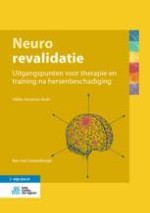Samenvatting
Ons zenuwstelsel beschikt over een aantal ingebouwde herstelmechanismen die nog kunnen worden gestimuleerd en aangevuld, onder andere door gerichte training en omgevingsaanpassing. Bij herstel na perifeer zenuwletsel ligt het accent op het herstel van de neurale bedrading, aanvankelijk een voorlopige, later een definitieve. Bij centrale laesies gaat het meer om het vinden van een andere strategie: andere taakverdeling van deelnemende hersengebieden (neurale reorganisatie), activeren van hersengebieden (opheffing van diaschisis/shock), inzet van andere functies (compensaties) en het bedenken en aanbrengen van omgevingsaanpassingen. Het vinden van deze nieuwe strategieën vindt plaats in etappes en kan jaren duren. Het betreft niet alleen motoriek (‘lopen’), maar ook taal, geheugen, aandacht, emoties, interesse en sociale vaardigheden. Bij neurodegeneratieve ziekten zijn continu plastische herstelmechanismen actief; soms zo effectief dat er ondanks de ziekte geen manifeste symptomen zijn. De mate van herstel hangt van vele factoren af, waarvan sommige duidelijk beïnvloed kunnen worden. Enkele liggen op het medische vlak (farmaca, stimulatietechnieken, transplantatie, medische conditie), maar de meeste zijn niet medisch van aard: motivatie, inzicht, support, omgevingsstructuur, fysiotherapie, logopedie en ergotherapeutische interventies.
